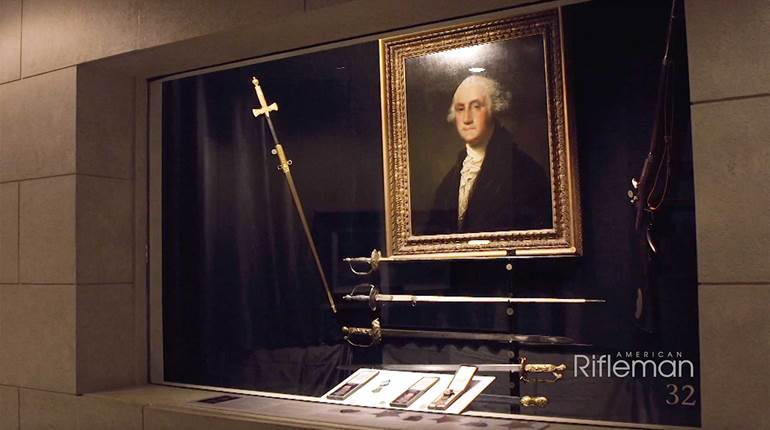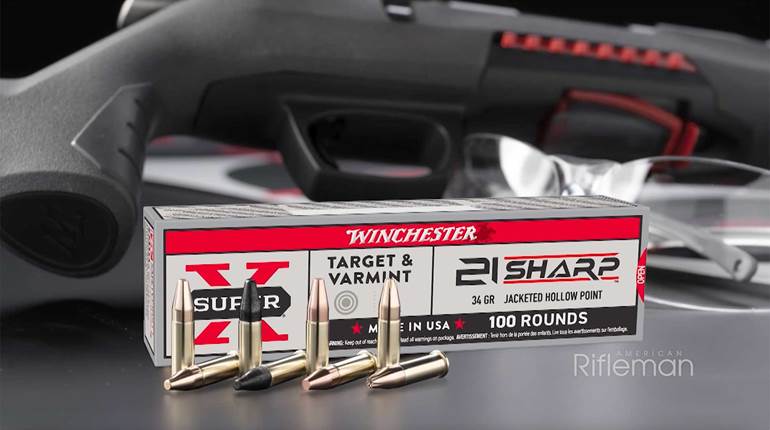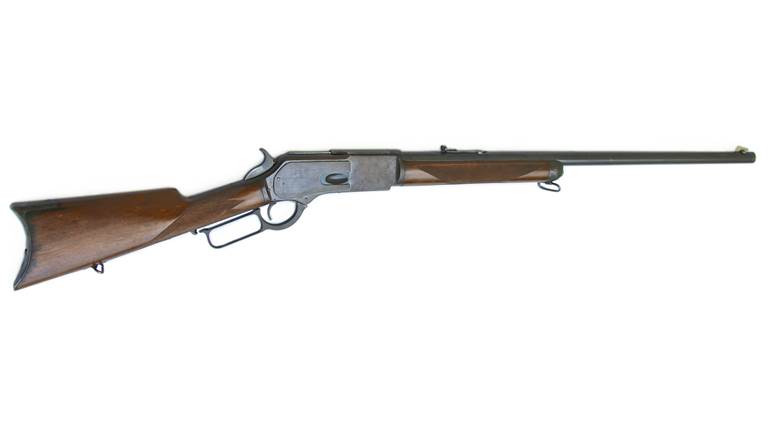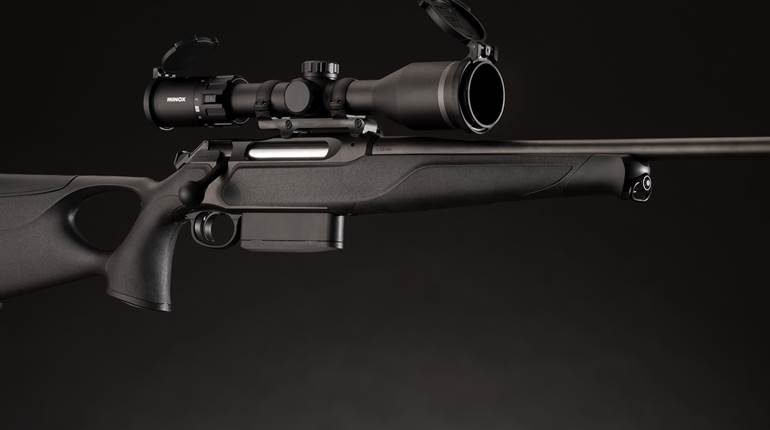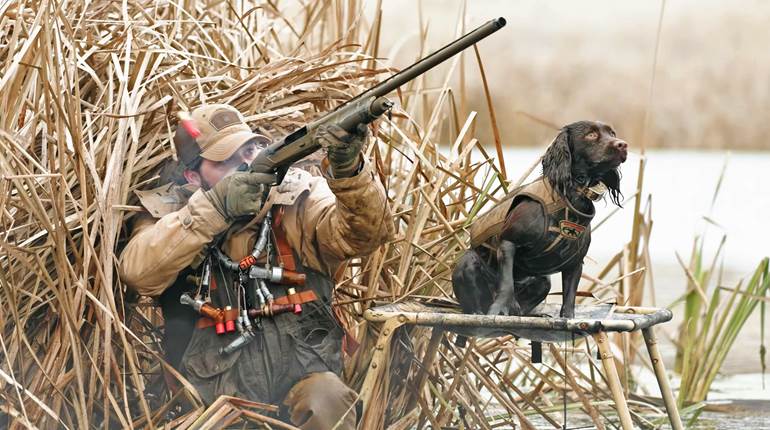
6/12/2013
“Bemis Heights (Saratoga) 7 Oct., 1777” by H. Charles McBarron; Courtesy of the Army Art Collection, U.S. Army Center of Military History
On the morning of Oct. 7, 1777, Timothy Murphy, a Continental Army sergeant and master sniper, loaded a lead ball into his American longrifle while perched in a tree on the edge of the Second Battle of Saratoga in upstate New York. His target was a man on a horse 300 yards distant.
British troops under the command of Simon Fraser, a Scottish aristocrat and British brigadier general, were rallying on the battlefield for what seemed to be an imminent victory over Colonial troops, a triumph that could put an end to the American Revolution.
Spotting the British general’s success at marshalling his troops for a final attack, Gen. Benedict Arnold, then considered the finest officer in the American army and George Washington’s anointed favorite general, called out to Daniel Morgan, commander of an elite brigade of Virginia riflemen: “That man on the grey horse is a host unto himself and must be disposed of—direct the attention of some of the sharpshooters amongst your riflemen to him!”
Colonel Morgan then said to Murphy, one of his finest marksmen, “That gallant officer is General Fraser. I admire him, but it is necessary that he should die. Do your duty.”
From his shooting perch in a tree, Murphy pointed his flintlock longrifle at the general, riding on a hill some 300 yards away, and squeezed the trigger.
As the rifle’s hammer dropped, the firearm’s surprisingly slow process of ignition unfolded, a fragile, complex procedure that on a flintlock rifle is nowhere near as fast as the firing of a modern cartridge arm.
When I first fired a vintage, blackpowder flintlock longrifle, I was amazed by two things. As a U.S. Navy SEAL, I was used to handling arms weighing 20 pounds and 40 pounds or more. But the typical American longrifle was around 9 pounds, a sleek, surprisingly lightweight gun, more like a precision combat surgical instrument than a battlefield tool.
And second, the process of firing the gun is incredibly slow. You line up your shot through the superb sighting system, and pull the trigger. Sparks shower as the flint strikes the frizzen. There’s a quick flash as the sparks ignite the powder in the pan, and a delayed sensation of contact in the gun. A little bit of smoke escapes from the pan as it ignites. A flash of flame passes through a hole into the breech of the barrel, which kicks off the powder charge behind the patched lead ball. Then a big puff of grayish smoke blasts out of the end of the barrel and the smoke fills the shooter’s whole field of vision. The rifle is so light that, rather than a sharp rap, the recoil feels more like a push against the shoulder.
If the wind was right, and if he’d used enough blackpowder for the ball to travel faster than sound, Murphy might have heard dull cracks from sonic reflections echoing back as the projectile passed the nearby trees. Meanwhile, the bullet continued toward the British general.
Throughout the war, British officers were horrified to see American riflemen like Murphy intentionally aiming at enemy officers as a way of decapitating the opposing leadership, as well as aiming at other strategic targets of opportunity such as Native American guides and British artillerymen. In the earlier combat at Saratoga, rebel riflemen hiding in and around trees had shredded the lines of stunned British officers.
For the American riflemen, the tactics of hit-and-run, concealment, ambush and surprise, and targeted killings were simply smart guerilla tactics. To the Brits, they were war crimes, pure and simple.
The commanding British general at the battle, Gen. John Burgoyne, who was the boss of Brig. Gen. Fraser at the Battle of Saratoga, later wrote of the sudden deadly impact of the American riflemen: “The enemy had with their army great numbers of marksmen, armed with rifle-barrel pieces; these, during an engagement, hovered upon the flanks in small detachments, and were very expert in securing themselves, and in shifting their ground. In this action many placed themselves in high trees in the rear of their own line, and there was seldom a minute’s interval of smoke, in any part of our line without officers being taken off by a single shot.”
The British feared the Colonial riflemen so much they called them “widow-makers.” Indeed the best picture of American riflemen comes from the unfortunate British troops who had to face them in battle. British Capt. Henry Beaufoy wrote that his combat-hardened troops, “when they understood they were opposed by riflemen ... felt a degree of terror never inspired by general action, from the idea that a rifleman always singled out an individual, who was almost certain of being killed or wounded.” He explained that the Americans “were in the habit of forming themselves into small bands often of twelve, who, accustomed to shooting in hunting parties, went out in a sort of predatory warfare, each carrying his ammunition and provisions and returning when he was exhausted. From the incessant attacks of these bodies, their opponents could never be prepared: as the first knowledge of a patrol in the neighbourhood was generally given by a volley of well-directed fire, that perhaps killed or wounded the greater part.”
Col. George Hanger, a British officer who served in South Carolina, was so impressed by the American’s deadly skill he wrote to the folks back home: “I never in my life saw better rifles (or men who shot better) than those made in America.” Another British officer reported that an expert rifleman could hit the head of a man at 200 yards, and if he “were to get perfect aim at 300 yards at me, standing still, he would most undoubtedly hit me unless it were a very windy day.”
The British had never heard of such behavior as the deliberate targeting of officers, and they were totally shocked. To them it seemed repulsive, very un-European and a tactic born of sheer cowardice. But their leaders like Fraser had not fully absorbed the implications of the tactic, and on this day on the battlefield at Saratoga, Fraser was a sitting duck, out in the open, and he had fallen into the gun-sight picture of Timothy Murphy’s eye.
The British general could actually see Murphy in his distant sniper post in the tree, but at 300 yards away he probably felt in little danger. His own troops, for example, were armed mainly with British Army regulation .75-cal. “Brown Bess” muskets, which—because of their quicker-loading smooth bores—usually couldn’t hit much past 80 yards on purpose.
Murphy’s bullet missed. Instead of hitting Gen. Fraser, it lightly nicked his horse. Murphy, who reportedly was armed with a rare handmade double-barreled rifle, would have pulled a catch to flip up the pre-loaded bottom barrel. He would have performed a quick series of complex mental calculations, trying to adjust his aim for wind, elevation, and for the inevitable vertical and lateral drift of the bullet, which at that far distance could be severe.
The American sniper fired again. The second bullet missed, again clipping the general’s horse. At that point, Murphy either would have paused to begin the time-consuming process of reloading his flintlock longrifle, which even for a crack shot like Murphy could have taken as long as 30 seconds, or more likely, someone would have passed him up another, pre-loaded longrifle.
In any event, Sgt. Timothy Murphy lined up his target for his third attempt. The fate of the United States of America hung in the balance. He squeezed the trigger. The bullet flew.
The guns used by Sgt. Murphy were uniquely American. In fact, I would argue the American longrifle is the arm that made the United States of America. It opened up the frontier, penetrated the wilderness, served as an engine of American commerce and family life, conquered human and natural enemies, and helped enable European settlers to overthrow the shackles of tyranny and establish the beginnings of a great nation in a vast, rugged and often hostile land.
Like the country itself, American longrifles were the heirs of a long tradition of European knowhow. And yet they were also uniquely transformed for use in the rugged New World frontier.
The new nation of America was forged by rugged settlers, trappers, and soldiers often armed with American longrifles, which were first produced by European-born gunsmiths in the 1620s and adapted from the shorter-barreled, larger-caliber Swiss-German Jaeger hunting rifle used in the forests of central Europe.
The lighter Americanized guns featured barrels of up to four feet in length, often adorned with nicknames and personalized designs and inscriptions. The new guns were noted to be “long, graceful and accurate in both hunting and warfare.”
This gun and its close relatives saw action in the French and Indian Wars, the American Indian Wars, the American Revolutionary War, the War of 1812, the Texas War of Independence, and in countless long-forgotten battles with lethal animal predators. It fed America, freed it from tyranny, and set it on a course toward astonishing growth and prosperity.
The American longrifle was also known as “the Kentucky rifle”—as Kentucky was once the catch-all word used to describe much of the little-known Western wilderness of the Appalachians and beyond—and “the Pennsylvania rifle,” as Lancaster and other Pennsylvania towns were a “Silicon Valley” of innovation and creativity for gun designers in the 1700s.
In his 1924 book The Kentucky Rifle, John Dillin traced its evolution as a kind of rhapsody: “From a flat bar of soft iron, hand forged into a gun barrel; laboriously bored and rifled with crude tools; fitted with a stock hewn from a maple tree in the neighboring forest; and supplied with a lock hammered to shape on the anvil; an unknown smith, in a shop long since silent, fashioned a rifle which changed the whole course of world history; made possible the settlement of a continent; and ultimately freed our country of foreign domination. Light in weight; graceful in line; economical in consumption of powder and lead; fatally precise; distinctly American; it sprang into immediate popularity; and for a hundred years was a model often slightly varied but never radically changed.”
The next time you feel especially proud to be an American, you might like to take a minute to think of a rifle commander named Daniel Morgan, who was Sgt. Tim Murphy’s commanding officer that day on at Saratoga, and his squads of riflemen from the villages and backwoods of Pennsylvania, Virginia, Kentucky and elsewhere on the frontier. And you might like to say a private word of thanks to them, because they were vitally important in the creation of the United States.
I feel connected to Dan Morgan and his riflemen for another reason, too. My seventh great-grandfather on my father’s side, a fellow from Virginia named Samuel Houston, was reported by his own son to have been one of Morgan’s riflemen, and at least one account places him with Morgan and Murphy at Saratoga, as an officer and paymaster. As paymaster, I’d wager he was popular among the troops! I served in the Iraq War as a U.S. Navy SEAL sniper, and if these accounts of Sam Houston’s service are true, it turns out I’ve got sniper’s blood in me going way back to the Revolutionary War. (Believe it or not, I didn’t find out about this until I was researching this book.)
Dan Morgan was a big, ornery, professional wagon-driver with a strong taste for liquor, gambling, getting into fights and pre-marital sex. He set up house with a gal named Abigail Curry “without benefit of clergy,” as they said back in those days, who bore him two daughters before finally marrying her in 1774. He was also one of the greatest marksmen in Colonial America. Remember, this was a country of sharpshooters on the frontier, a country where every week, from Maine to Georgia, shooting contests were held where civilian riflemen attempted to snuff out the light of a distant candle without damaging the wick or candle.
The American longrifle brandished by Morgan and his riflemen was not the main infantry arm of the rebellious Colonists, not by a long shot. Less than 10 percent of the American troops carried them. The most common infantry gun for both sides in the Revolutionary War was the European-style smoothbore flintlock musket, which had a shorter range than the longrifle but had the advantages of being faster to reload—15 seconds was a typical reload time, twice as fast as the longrifle—and unlike the longrifle, it could be fitted with a bayonet, which was very handy for close-quarter combat. And in the worst case, you could swing a musket like a club and do some damage. Not so with the longrifle. If you tried to clobber someone with a longrifle, chances are it would snap into pieces.
I’ve been in some hairy combat scrapes myself, but it’s difficult to picture how tough it would have been to work an American longrifle on the battlefield. After you fired one round, you had to stand up and fiddle with pouring an exact measurement of dry powder into the muzzle, plus lead ball, and push it in with a long wooden rod, all the while praying to God to save you from the wind blowing your powder all over your boots, or the rain gumming up the mechanism, or an all-too-common misfire, or getting shot while standing up fully exposed out in the open for 30 seconds. No wonder so many riflemen hid behind trees whenever they could.
The longrifle’s lack of a bayonet occasionally proved tragic for the Americans. At Guan Heights during the Battle of Long Island on Aug. 20 and 21, 1776, Hessian mercenary troops armed with faster-loading, bayonet-tipped muskets overwhelmed troops of Gen. John Sullivan’s rifle battalion while the Americans were trying to reload. Many Americans were quickly slaughtered in macabre fashion. “The greater part of the riflemen,” recalled one Hessian officer, “were pierced with the bayonet to the trees.”
In fact, many of the great battles of the war did not feature American guerilla attacks from the woods. Instead, they were head-on, open-air shoot-outs, bayonet charges and slugfests featuring British troops often armed with Brown Bess muskets, facing Colonial troops armed with an assortment of European-sourced muskets and locally produced copies, with both sides supported by cavalry, artillery and other accoutrements of war, including sabers, some flintlock pistols and even tomahawks and hatchets.
Following the logic of musket technology, and the traditions of European military tactics, musket firing on both sides was typically group-volley fire at enemy linear formations en masse at short ranges, rather than individually aimed fire at specific long-distance targets. Even the Revolutionaries’ legendary hit-and-run pursuit of British troops from Lexington and Concord through woods and country roads at the start of the war on April 19, 1775, was conducted by Colonial militia mostly armed with muskets and bird guns known as “fowling pieces,” not longrifles. The epic American defense of Bunker Hill and Breeds Hill two months later was fought mainly with muskets, too.
But American riflemen and their longrifles, which were originally designed not to kill British soldiers but to nail small-to-medium-sized game on the frontier—as well as hostile Indians—provided a powerful extra edge to the Revolutionaries in several critical moments of the war. The rifling of the longrifle’s barrel imparted spin on the ball as it flew out of the muzzle, greatly increasing its stability in flight and thereby its accuracy over the smoothbore musket.
Through the Revolutionary War, Gen. Washington periodically deployed companies of riflemen, such as Morgan and Murphy, as long-range scouts, rangers, skirmishers and snipers, and as a shock force that could, when they were available, provide a powerful overlay to Continental Army regulars and Colonial militia. And in several pivotal moments, the frontier-bred riflemen from places such Pennsylvania, Maryland and Virginia delivered spectacularly, and may even have affected the course of the war and sped the American victory.
Which brings us back to the battlefield at Saratoga, at around 11 a.m. on Oct. 7, 1777.
Sgt. Timothy Murphy’s third shot found its target. It squarely hit British Gen. Simon Fraser in his belly, who probably never dreamed he was in danger of being shot from so far away, at least not 300 yards. Murphy’s bullet created one of the most painful of battle injuries, a stomach wound. As he lay dying, Fraser spoke of seeing the American rifleman who shot him, far off in the distance.
When they saw their leader fall and get dragged off the battlefield, British troops panicked, broke ranks and soon fell back in retreat. The tide of battle was reversed. The loss of Gen. Fraser, explained his boss, Gen. Burgoyne, “helped to turn the fate of the day.” Ten days later, he and 6,000 British troops surrendered to the Americans, handing them a spectacular victory.
I like to think of my ancestor, Sam Houston, standing beside Morgan, Murphy and the other American riflemen, proudly clutching their longrifles as they watched the redcoats surrender. It’s recorded that the Americans graciously treated the defeated British officers to a delicious feast to show their honor. If my seventh great-grand-daddy was part of the festivities and if his appetite was anything like mine, I’ll bet he had a prime spot in the chow line.
The American triumph at Saratoga, the first time the rebels beat the British in a set-piece battle, stopped the British plan to sever the rebellious Colonies in two. And in Paris, the French ministers of government were so impressed that they soon decided to formally enter the war on the American side, a development most historians now believe meant that from that moment on, in the long run, the war was essentially won, or at least the chances of defeat were radically reduced.













